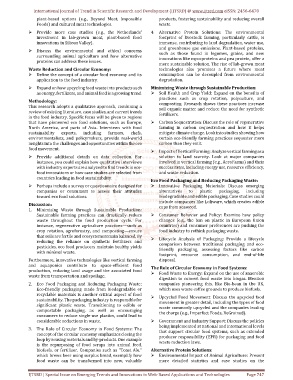Page 757 - Emerging Trends and Innovations in Web-Based Applications and Technologies
P. 757
International Journal of Trend in Scientific Research and Development (IJTSRD) @ www.ijtsrd.com eISSN: 2456-6470
plant-based options (e.g., Beyond Meat, Impossible products, fostering sustainability and reducing overall
Foods) and cultured meat technologies. waste.
Provide more case studies (e.g., the Netherlands’ 4. Alternative Protein Solutions: The environmental
investment in lab-grown meat, plant-based food footprint of livestock farming, particularly cattle, is
innovations in Silicon Valley). immense, contributing to land degradation, water use,
and greenhouse gas emissions. Plant-based proteins,
Discuss the environmental and ethical concerns such as those found in legumes, grains, and new
surrounding animal agriculture and how alternative innovations like mycoproteins and pea protein, offer a
proteins can address these issues.
more sustainable solution. The rise of lab-grown meat
Waste Reduction and Circular Economy: technologies also promises a future where meat
Define the concept of a circular food economy and its consumption can be decoupled from environmental
application to the food industry. degradation.
Expand on how upcycling food waste into products such Minimizing Waste through Sustainable Production:
as energy, fertilizers, and animal feed is a growing trend. Soil Health and Crop Yield: Expand on the benefits of
practices such as crop rotation, polyculture, and
Methodology: composting. Research shows these practices increase
This research adopts a qualitative approach, combining a soil organic matter and reduce the need for synthetic
review of existing literature, case studies, and current trends
fertilizers.
in the food industry. Specific focus will be given to regions
that have pioneered eco food solutions, such as Europe, Carbon Sequestration: Discuss the role of regenerative
North America, and parts of Asia. Interviews with food farming in carbon sequestration and how it helps
sustainability experts, including farmers, chefs, mitigate climate change. Look into studies showing how
environmentalists, and policymakers, provide real-world certain eco-friendly farming practices sequester more
insights into the challenges and opportunities within the eco carbon than they emit.
food movement.
Impact of Vertical Farming: Analyze vertical farming as a
Provide additional details on data collection. For solution to land scarcity. Look at major companies
instance, you could explain how qualitative interviews involved in vertical farming (e.g., AeroFarms) and their
with industry experts are analyzed to find trends in eco- success rates, including energy use, resource efficiency,
food innovations or how case studies are selected from and waste reduction.
countries leading in food sustainability.
Eco Food Packaging and Reducing Packaging Waste:
Perhaps include a survey or questionnaire designed for Innovative Packaging Materials: Discuss emerging
companies or consumers to assess their attitudes alternatives to plastic packaging, including
toward eco food solutions. biodegradable and edible packaging. Case studies could
include companies like Loliware, which creates edible
Discussion:
cups from seaweed.
1. Minimizing Waste through Sustainable Production:
Sustainable farming practices can drastically reduce Consumer Behavior and Policy: Examine how policy
waste throughout the food production cycle. For changes (e.g., the ban on plastic in European Union
instance, regenerative agriculture practices—such as countries) and consumer preferences are pushing the
crop rotation, agroforestry, and composting—ensure food industry to rethink packaging waste.
that soils are fertile and ecosystems remain balanced. By
Lifecycle Analysis of Packaging: Provide a lifecycle
reducing the reliance on synthetic fertilizers and
comparison between traditional packaging and eco-
pesticides, eco food producers maintain healthy yields
friendly packaging, assessing factors like carbon
with minimal waste.
footprint, resource consumption, and end-of-life
Furthermore, innovative technologies like vertical farming disposal.
and aquaponics contribute to space-efficient food The Role of Circular Economy in Food Systems:
production, reducing land usage and the associated food
Food Waste to Energy: Expand on the use of anaerobic
waste from transportation and spoilage.
digestion to convert food waste into biogas. Mention
2. Eco Food Packaging and Reducing Packaging Waste: companies pioneering this, like Bio-bean in the UK,
Eco-friendly packaging made from biodegradable or which uses waste coffee grounds to produce biofuels.
recyclable materials is another critical aspect of food Upcycled Food Movement: Discuss the upcycled food
sustainability. The packaging industry is responsible for movement in greater detail, including the types of food
significant plastic waste. Transitioning to edible or waste commonly upcycled and the companies leading
compostable packaging, as well as encouraging the charge (e.g., Imperfect Foods, ReGrained).
consumers to reduce single-use plastics, could lead to
considerable reductions in waste. Government and Industry Support: Discuss the policies
being implemented at national and international levels
3. The Role of Circular Economy in Food Systems: The that support circular food systems, such as extended
concept of the circular economy emphasizes closing the producer responsibility (EPR) for packaging and food
loop by reusing materials and by-products. One example waste reduction laws.
is the repurposing of food scraps into animal feed,
biofuels, or fertilizer. Companies such as "Toast Ale," Alternative Protein Solutions:
which brews beer using surplus bread, exemplify how Environmental Impact of Animal Agriculture: Present
food waste can be transformed into new, valuable more detailed statistics and case studies on the
IJTSRD | Special Issue on Emerging Trends and Innovations in Web-Based Applications and Technologies Page 747

